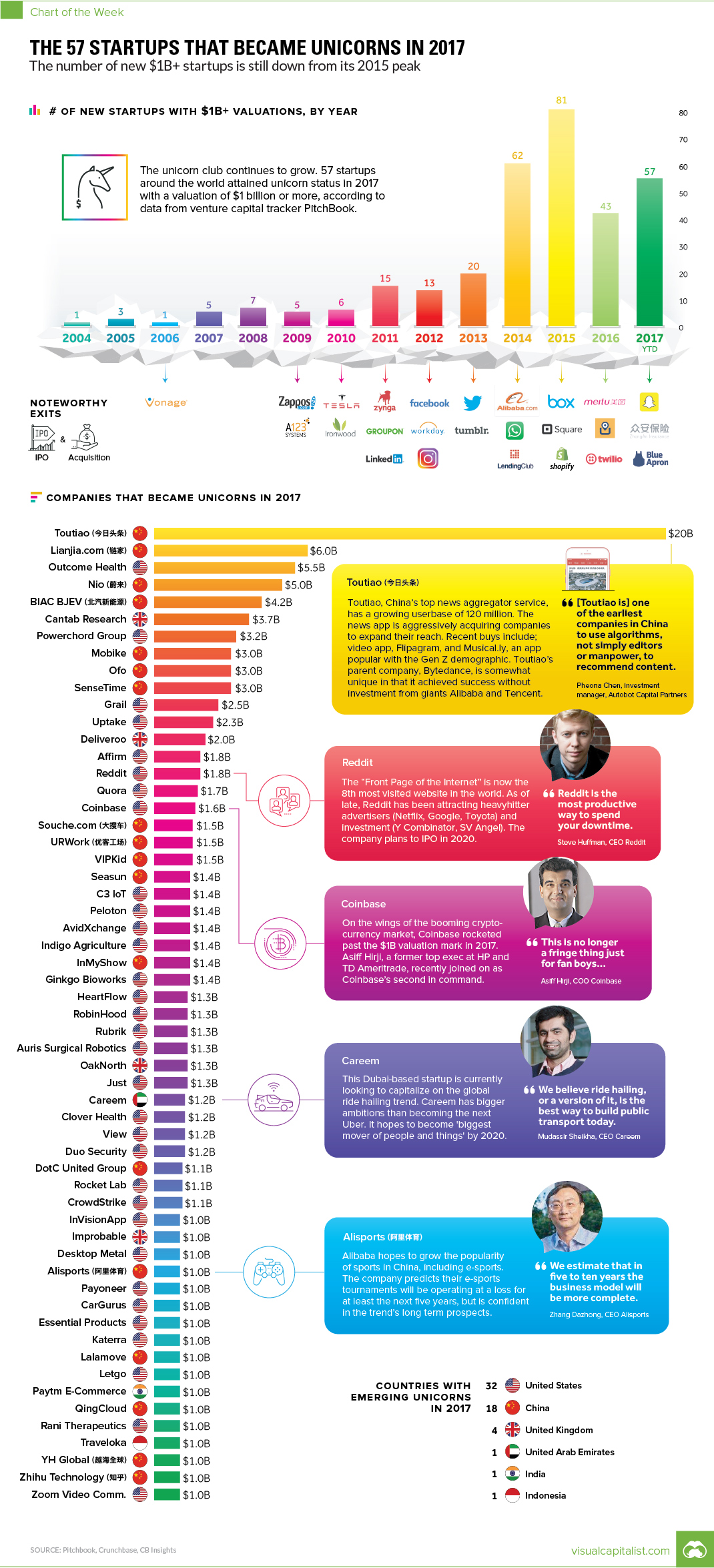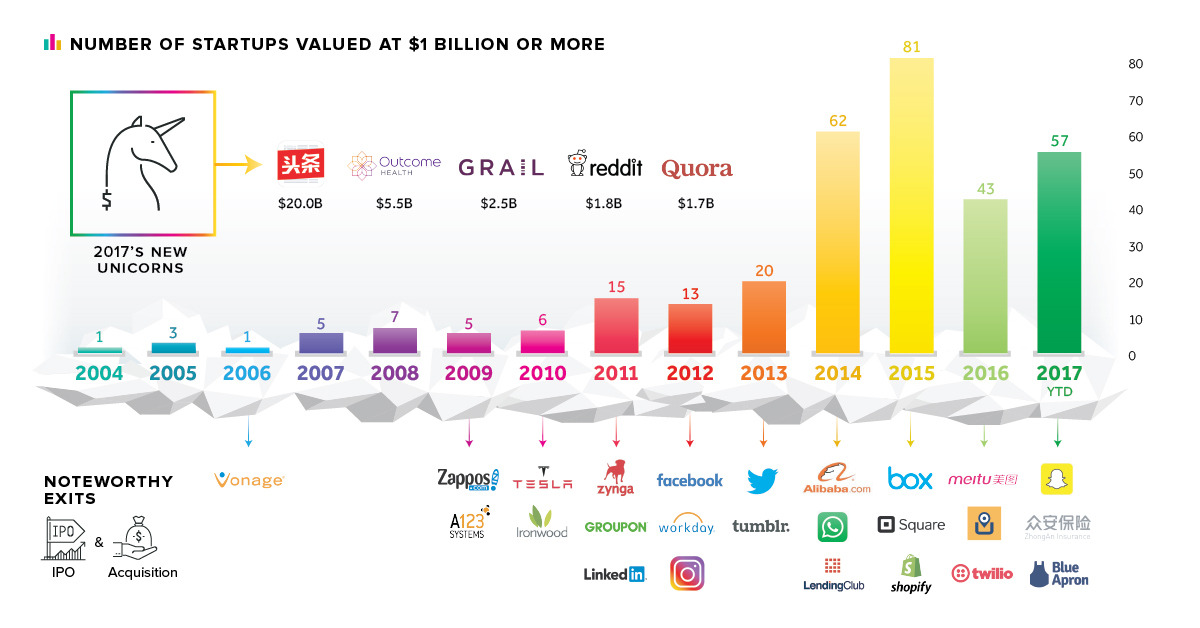Technology
The 57 Startups That Became Unicorns in 2017

57 New Unicorns in 2017
Collectively, they’re now worth $116.5B
The Chart of the Week is a weekly Visual Capitalist feature on Fridays.
For a startup, reaching the coveted $1 billion unicorn valuation is an important milestone – but as we’ve found out in recent years, it’s not necessarily a guarantee of future success.
In 2017, there were 57 startups that crossed the unicorn threshold, and they range from well-known companies, such as Reddit or Quora, to rapid-risers like China’s Toutiao (now valued at $20 billion), which has seemingly come out of nowhere.
Investors have conviction that these companies will provide the platforms and products of the future, and they are placing big bets on them to deliver.
Will they live up to the hype, or will they ultimately end up in the unicorn graveyard?
Unicorn Births by Year
With 57 new unicorns, this year ranks third overall in terms of births per year.
| Year | # of Unicorns | Notable Unicorn Birth |
|---|---|---|
| 2009 | 5 | BloomEnergy |
| 2010 | 6 | Groupon |
| 2011 | 15 | Airbnb |
| 2012 | 13 | |
| 2013 | 20 | Uber |
| 2014 | 62 | Slack |
| 2015 | 81 | Vox Media |
| 2016 | 43 | Compass |
| 2017 | 57 |
While 57 unicorns in 2017 is still a high number, it’s also clear that the froth has died down from the unicorn bonanza that occurred in 2015.
Venture capitalists have clearly dialed it down a notch, re-focusing on the selective quality of investments rather than the overall quantity of big bets.
Notable Unicorns in 2017
Based on data from PitchBook, we’ve included the full list of unicorns in the chart today.
However, here are some that caught our eye:
Toutiao (China)
Valuation: $20 billion
Founded in 2012, Toutiao is the behemoth on this year’s new unicorn list. Based in Beijing, Toutiao is a news and information platform that focuses on recommendations using AI technology. The company pushes content to users based on previous user interactions as well as the detailed analysis of new content. The platform has 120 million active users and has also gone on a recent buying spree, acquiring names like Flipagram and Musical.ly.
Coinbase (United States)
Valuation: $1.6 billion
The cryptocurrency sector is exploding with growth, and Coinbase has been along for the ride since 2012. The most important crypto platform in the U.S. has such a strong influence in the sector, that the “Coinbase Effect” is now a talking point for traders everywhere. Whenever Coinbase introduces a cryptocurrency to its base of 10 million users, the added visibility and liquidity can make the price go bananas. It’s happened with Litecoin and Bitcoin Cash so far, and now every move by Coinbase is closely tracked by crypto power users and influencers.
Alisports (China)
Valuation: $1.0 billion
Alibaba’s foray into sports isn’t going unnoticed. In conjunction with Sina Corp (a Chinese telecom) and Yunfeng Capital Co (venture capital), Alibaba hopes that Alisports will carve out a huge chunk of the RMB 5 Trillion Chinese sports market. It’s also worth noting that Alisports sees e-sports as having huge potential, and as a central piece of its platform.
Technology
Ranked: Semiconductor Companies by Industry Revenue Share
Nvidia is coming for Intel’s crown. Samsung is losing ground. AI is transforming the space. We break down revenue for semiconductor companies.
Semiconductor Companies by Industry Revenue Share
This was originally posted on our Voronoi app. Download the app for free on Apple or Android and discover incredible data-driven charts from a variety of trusted sources.
Did you know that some computer chips are now retailing for the price of a new BMW?
As computers invade nearly every sphere of life, so too have the chips that power them, raising the revenues of the businesses dedicated to designing them.
But how did various chipmakers measure against each other last year?
We rank the biggest semiconductor companies by their percentage share of the industry’s revenues in 2023, using data from Omdia research.
Which Chip Company Made the Most Money in 2023?
Market leader and industry-defining veteran Intel still holds the crown for the most revenue in the sector, crossing $50 billion in 2023, or 10% of the broader industry’s topline.
All is not well at Intel, however, with the company’s stock price down over 20% year-to-date after it revealed billion-dollar losses in its foundry business.
| Rank | Company | 2023 Revenue | % of Industry Revenue |
|---|---|---|---|
| 1 | Intel | $51B | 9.4% |
| 2 | NVIDIA | $49B | 9.0% |
| 3 | Samsung Electronics | $44B | 8.1% |
| 4 | Qualcomm | $31B | 5.7% |
| 5 | Broadcom | $28B | 5.2% |
| 6 | SK Hynix | $24B | 4.4% |
| 7 | AMD | $22B | 4.1% |
| 8 | Apple | $19B | 3.4% |
| 9 | Infineon Tech | $17B | 3.2% |
| 10 | STMicroelectronics | $17B | 3.2% |
| 11 | Texas Instruments | $17B | 3.1% |
| 12 | Micron Technology | $16B | 2.9% |
| 13 | MediaTek | $14B | 2.6% |
| 14 | NXP | $13B | 2.4% |
| 15 | Analog Devices | $12B | 2.2% |
| 16 | Renesas Electronics Corporation | $11B | 1.9% |
| 17 | Sony Semiconductor Solutions Corporation | $10B | 1.9% |
| 18 | Microchip Technology | $8B | 1.5% |
| 19 | Onsemi | $8B | 1.4% |
| 20 | KIOXIA Corporation | $7B | 1.3% |
| N/A | Others | $126B | 23.2% |
| N/A | Total | $545B | 100% |
Note: Figures are rounded. Totals and percentages may not sum to 100.
Meanwhile, Nvidia is very close to overtaking Intel, after declaring $49 billion of topline revenue for 2023. This is more than double its 2022 revenue ($21 billion), increasing its share of industry revenues to 9%.
Nvidia’s meteoric rise has gotten a huge thumbs-up from investors. It became a trillion dollar stock last year, and broke the single-day gain record for market capitalization this year.
Other chipmakers haven’t been as successful. Out of the top 20 semiconductor companies by revenue, 12 did not match their 2022 revenues, including big names like Intel, Samsung, and AMD.
The Many Different Types of Chipmakers
All of these companies may belong to the same industry, but they don’t focus on the same niche.
According to Investopedia, there are four major types of chips, depending on their functionality: microprocessors, memory chips, standard chips, and complex systems on a chip.
Nvidia’s core business was once GPUs for computers (graphics processing units), but in recent years this has drastically shifted towards microprocessors for analytics and AI.
These specialized chips seem to be where the majority of growth is occurring within the sector. For example, companies that are largely in the memory segment—Samsung, SK Hynix, and Micron Technology—saw peak revenues in the mid-2010s.
-

 Real Estate2 weeks ago
Real Estate2 weeks agoVisualizing America’s Shortage of Affordable Homes
-

 Technology1 week ago
Technology1 week agoRanked: Semiconductor Companies by Industry Revenue Share
-

 Money1 week ago
Money1 week agoWhich States Have the Highest Minimum Wage in America?
-

 Real Estate1 week ago
Real Estate1 week agoRanked: The Most Valuable Housing Markets in America
-

 Business1 week ago
Business1 week agoCharted: Big Four Market Share by S&P 500 Audits
-

 AI2 weeks ago
AI2 weeks agoThe Stock Performance of U.S. Chipmakers So Far in 2024
-

 Misc2 weeks ago
Misc2 weeks agoAlmost Every EV Stock is Down After Q1 2024
-

 Money2 weeks ago
Money2 weeks agoWhere Does One U.S. Tax Dollar Go?














